The iPhone 5 Review
by Anand Lal Shimpi, Brian Klug & Vivek Gowri on October 16, 2012 11:33 AM EST- Posted in
- Smartphones
- Apple
- Mobile
- iPhone 5
GPU Analysis/Performance
Section by Anand Shimpi
Understanding the A6's GPU architecture is a walk in the park compared to what we had to do to get a high level understanding of Swift. The die photos give us a clear indication of the number of GPU cores and the width of the memory interface, while the performance and timing of release fill in the rest of the blanks. Apple has not abandoned driving GPU performance on its smartphones and increased the GPU compute horsepower by 2x. Rather than double up GPU core count, Apple adds a third PowerVR SGX 543 core and runs the three at a higher frequency than in the A5. The result is roughly the same graphics horsepower as the four-core PowerVR SGX 543MP4 in Apple's A5X, but with a smaller die footprint.
As a recap, Imagination Technologies' PowerVR SGX543 GPU core features four USSE2 pipes. Each pipe has a 4-way vector ALU that can crank out 4 multiply-adds per clock, which works out to be 16 MADs per clock or 32 FLOPS. Imagination lets the customer stick multiple 543 cores together, which scales compute performance linearly.
SoC die size however dictates memory interface width, and it's clear that the A6 is significantly smaller in that department than the A5X, which is where we see the only tradeoff in GPU performance: the A6 maintains a 64-bit LPDDR2 interface compared to the 128-bit LPDDR2 interface in the A5X. The tradeoff makes sense given that the A5X has to drive 4.3x the number of pixels that the A6 has to drive in the iPhone 5. At high resolutions, GPU performance quickly becomes memory bandwidth bound. Fortunately for iPhone 5 users, the A6's 64-bit LPDDR2 interface is a good match for the comparatively low 1136 x 640 display resolution. The end result is 3D performance that looks a lot like the new iPad, but in a phone:
| Mobile SoC GPU Comparison | |||||||||||
| Adreno 225 | PowerVR SGX 540 | PowerVR SGX 543MP2 | PowerVR SGX 543MP3 | PowerVR SGX 543MP4 | Mali-400 MP4 | Tegra 3 | |||||
| SIMD Name | - | USSE | USSE2 | USSE2 | USSE2 | Core | Core | ||||
| # of SIMDs | 8 | 4 | 8 | 12 | 16 | 4 + 1 | 12 | ||||
| MADs per SIMD | 4 | 2 | 4 | 4 | 4 | 4 / 2 | 1 | ||||
| Total MADs | 32 | 8 | 32 | 48 | 64 | 18 | 12 | ||||
| GFLOPS @ 200MHz | 12.8 GFLOPS | 3.2 GFLOPS | 12.8 GFLOPS | 19.2 GFLOPS | 25.6 GFLOPS | 7.2 GFLOPS | 4.8 GFLOPS | ||||
We ran through the full GLBenchmark 2.5 suite to get a good idea of GPU performance. The results below are largely unchanged from our iPhone 5 Performance Preview, with the addition of the Motorola RAZR i and RAZR M. I also re-ran the iPad results on iOS 6, although I didn't see major changes there.
We'll start out with the raw theoretical numbers beginning with fill rate:
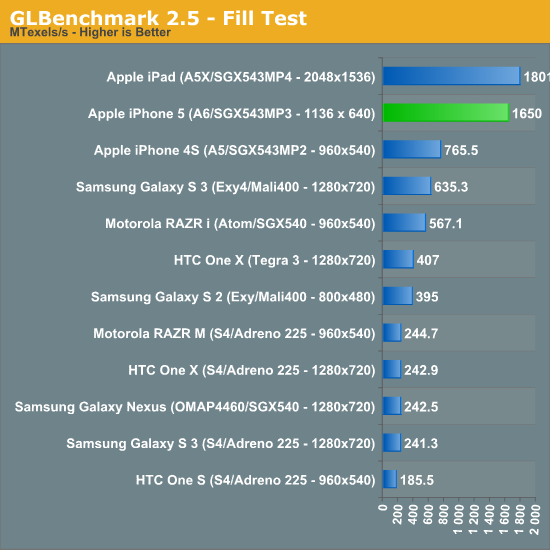
The iPhone 5 nips at the heels of the 3rd generation iPad here, at 1.65GTexels/s. The performance advantage over the iPhone 4S is more than double, and even the Galaxy S 3 can't come close.
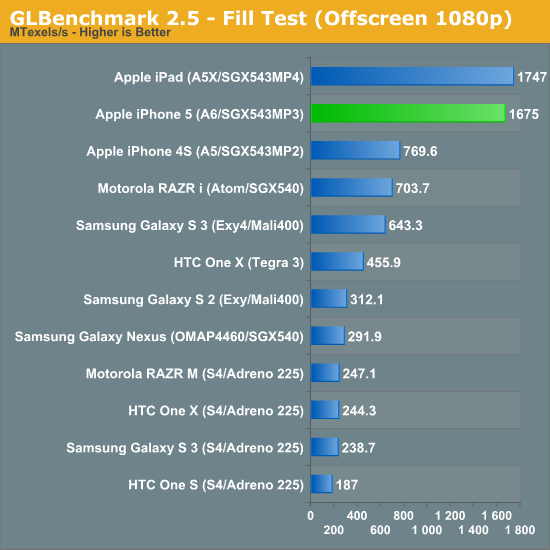
Triangle throughput is similarly strong:

Take resolution into account and the iPhone 5 is actually faster than the new iPad, but normalize for resolution using GLBenchmark's offscreen mode and the A5X and A6 look identical:
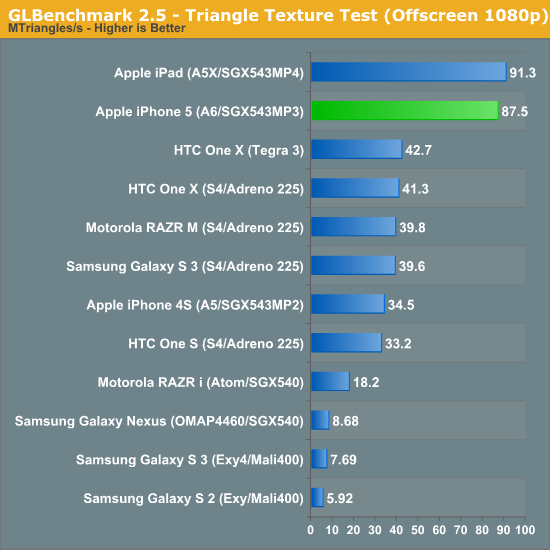
The fragment lit texture test does very well on the iPhone 5, once again when you take into account the much lower resolution of the 5's display performance is significantly better than on the iPad:
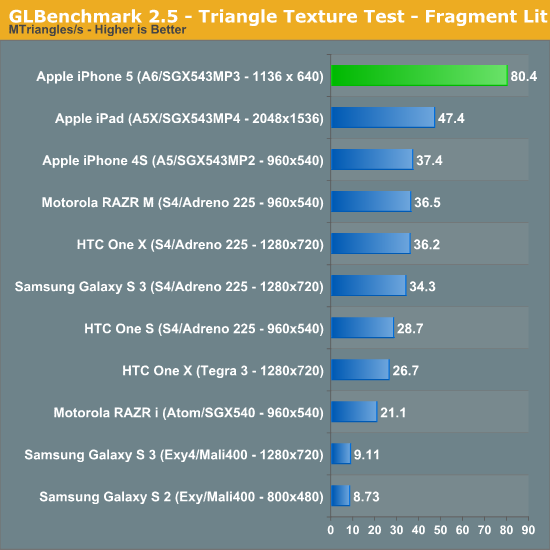
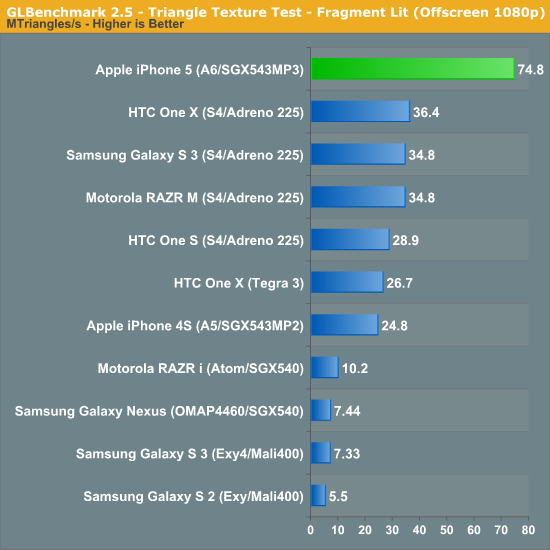

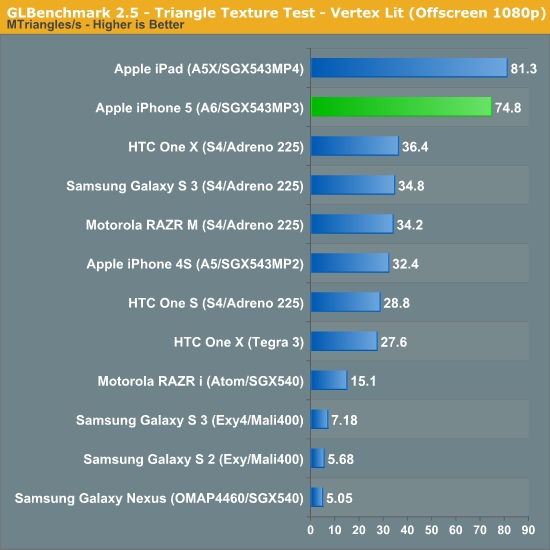
The next set of results are the gameplay simulation tests, which attempt to give you an idea of what game performance based on Kishonti's engine would look like. These tests tend to be compute monsters, so they'll make a great stress test for the iPhone 5's new GPU:
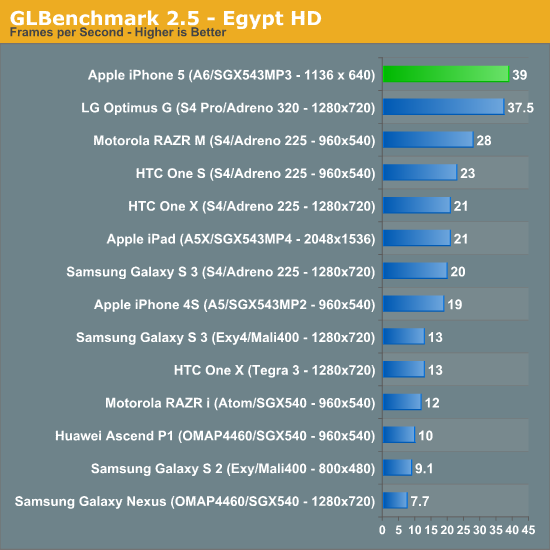
Egypt HD was the great equalizer when we first met it, but the iPhone 5 does very well here. The biggest surprise however is just how well the Qualcomm Snapdragon S4 Pro with Adreno 320 GPU does by comparison. LG's Optimus G, a device Brian flew to Seoul, South Korea to benchmark, is hot on the heels of the new iPhone.
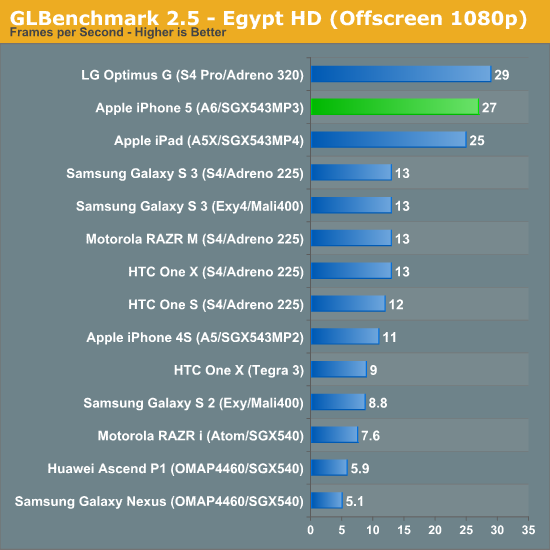
When we run everything at 1080p the iPhone 5 looks a lot like the new iPad, and is about 2x the performance of the Galaxy S 3. Here, LG's Optimus G actually outperforms the iPhone 5! It looks like Qualcomm's Adreno 320 is quite competent in a phone. Note just how bad Intel's Atom Z2460 is, the PowerVR SGX 540 is simply unacceptable for a modern high-end SoC. I hope Intel's slow warming up to integrating fast GPUs on die doesn't plague its mobile SoC lineup for much longer.
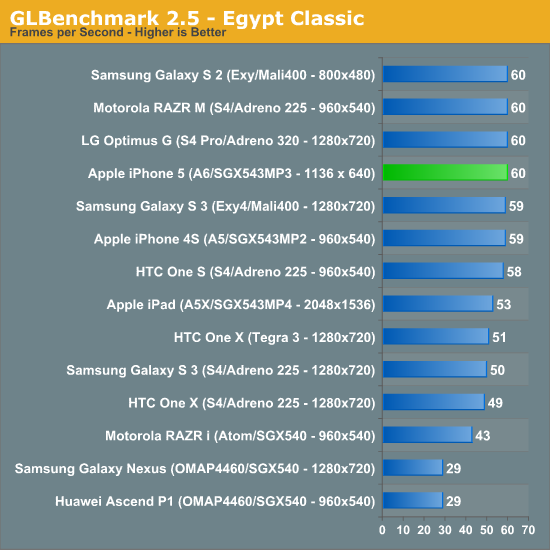
The Egypt classic tests are much lighter workloads and are likely a good indication of the type of performance you can expect from many games today available on the app store. At its native resolution, the iPhone 5 has no problems hitting the 60 fps vsync limit.
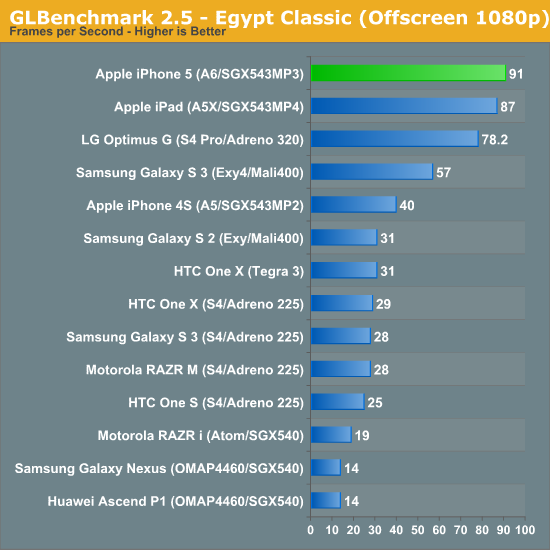
Remove vsync, render at 1080p and you see what the GPUs can really do. Here the iPhone 5 pulls ahead of the Adreno 320 based LG Optimus G and even slightly ahead of the new iPad.
Once again, looking at GLBenchmark's on-screen and offscreen Egypt tests we can get a good idea of how the iPhone 5 measures up to Apple's claims of 2x the GPU performance of the iPhone 4S:
Removing the clearly vsync limited result from the on-screen Egypt Classic test, the iPhone 5 performs about 2.26x the speed of the 4S. If we include that result in the average you're still looking at a 1.95x average. As we've seen in the past, these gains don't typically translate into dramatically higher frame rates in games, but games with better visual quality instead.











276 Comments
View All Comments
darwinosx - Tuesday, October 16, 2012 - link
The iPhone 5 display is better than any current Android display.But Motorola and Android if you want a company that is dying and being sold and a copycat cheap phone with no service and support.
V-Money - Tuesday, October 16, 2012 - link
Your wisdom and informative argument adds tremendous value to this post. For the record though, the OP said specifically battery life and 720p display, so the response was relevant.The rest of your post is petty, get over yourself. If you are going to play the copycat card you should have done it before Apple decided to go with a bigger screen and use a (eerily similar) notification bar to what Android phones have had for years.
As for quality (of display or otherwise), that is subjective analysis and considering that Apple only releases one phone at a time and Android manufacturers many, its a stupid argument for anyone to make. Case and point, I can find many android phones that are much more terrible than the iPhone, but I can also find many that are better. The iPhone is a decent phone, but its not for everyone. Every consumer has their preference.
My point being there is not one-size-fits-all phone, so quit acting high and mighty with your close mindedness. You are not better than those around you because you bought into Apple's marketing, you are just a fool dealing with the first world problem of living such a meaningless existence that you have to hold on to the imaginary power an inanimate object pretends to give to you.
Alucard291 - Tuesday, October 16, 2012 - link
I feel that your argument may be too good for him to reply to :)He seems awfully angry :D
crankerchick - Tuesday, October 16, 2012 - link
Great reply. If there's one place I just want to exchange comments without playing the "my toy is better than yours" game, it's here on AnandTech.Gradly - Wednesday, October 17, 2012 - link
I'm sick of ppl comparing iPhone to other devices. I'm sick of those telling you iPhone borrowed the notifications slider form android and skipping the myriad of things that other borrowed form iPhone. Apple has always said that "we are not the first but we do it the best". I'm sick of those who still don't realize that before iPhone ppl were living in caves actually.I'm an Apple lover not an Apple fanboy. I just adore the design, aesthetics, and GUI of Apple devices.
Penti - Wednesday, October 17, 2012 - link
It's sadly Apple that goes and patent UI-elements to use against their competitors that is why it's always brought up. It would be totally unnecessary otherwise. You might look at who's the inspiration otherwise and it's often not Apple. In reality we had capacitive touch screens (it's not Apples tech of course) before, app store before, Android even had an SDK out before Apple. Competitors like Symbian/Nokia, HP WebOS, and Blackberry are even allowed to use stuff like bounce back effect even without (or before) any agreement with Apple. They should have credit but they didn't all the sudden bring out their device with what we now call smartphone features, it lacked most functions at first and slowly iterated, it did a lot poorer in many areas then it's competitors was doing even before iPhone and the first few years it also showed in sales numbers which were not high at the first 2-3 years. It did show us how important a good platform was. Guys like Rubin had already figured that out though. So I'm not sure what they would borrow. Full WebKit-browsers on mobile is a good example of stuff they are co-developing but it was out in Nokia devices in 2006, netfront and Opera was never good alternatives to build into your platform. Stock Android don't have the bounce back effect, UI's looking like Apples and so on. Not even TouchWiz on Samsung's tablets looks like or infringes anything (design-wise) by Apple. They clearly have their own ideas. They are not the "me too", others might try to emulate them more in a business sense though. But they will be punished by the market by their execution instead of by Apple. It's not like any of the major players are fruit ninja-clones though.iPhone was desperately rudimentary at first. It didn't do applications and the web, messaging, photos etc better then anybody. What they did good was to iterate and improve. They take enterprise / corporate customers more seriously then Microsoft and so on in this field. Even if it took some time for them to get there. So they do plenty of good. It's a good platform, but it's not like they gave their competitors their blueprints for their devices / os of today back in 2007 and both have made many improvements. Well maybe not Microsoft but it takes a few years to start over. Apple has even got into hardware (components) a bit. Commoditization and convergence has reached far beyond the mobile field. That's great even if Apple won't enter them. Still don't know why any competitor would like to turn themselves into a retail giant and employ mostly store staff as Apple does – Microsoft should start doing what they are good at instead. Google would be the most evil company in the world if they had started to patent and sue based on UI-features and methods. Or if they really tried to stop Bing and Bing Maps (and getting it banned in some markets) for example. It doesn't really matter who was first and who invented what if you take it to court were that doesn't really count and that creates a lot of BS surrounding the whole issue and companies involved that is largely unnecessary. But the real silly thing is why they fight. It's not based on IPR, it's basically that they want to be alone in doing whatever, even if they can't really make that claim to have sole rights to something. But ultimately courts do get that under control even when corporate leaders turn to fighting outside of releasing product.
slickr - Tuesday, October 16, 2012 - link
LOL. Don't make me laugh. It has still the worst display and has had the worst display for at least 3 years.A5 - Tuesday, October 16, 2012 - link
Your response is just as dumb as his. The iPhones have excellent displays.medi01 - Wednesday, October 17, 2012 - link
None of the iPhones have anything to compare with AMOLEDs, on top of having idiotic resolution.On tablet space, only iPad 3 matched color gamut of THE FIRST Samsung Galaxy Tab.
thunng8 - Wednesday, October 17, 2012 - link
How does 67.5% of sRGB on the galaxy tab 10.1 match the 94.4% on the ipad 3?http://www.anandtech.com/show/5688/apple-ipad-2012...